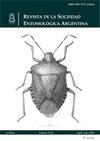Occurrence of kleptoparasitic sarcophagid flies (Diptera: Sarcophagidae: Miltogramminae) in natural and human modified sites in Southern South American Andean landscapes
IF 0.5
4区 农林科学
Q4 ENTOMOLOGY
引用次数: 1
Abstract
Sarcophagid flies belonging to the subfamily Miltogramminae are mainly kleptoparasites of bees and solitary wasps. Twenty-six locations were surveyed to accomplish the first specific exploration on the diversity of Miltogramminae in southern Andean areas of South America. We evaluated changes in abundance, richness and composition among habitat types to establish the effect of anthropization on the Miltogramminae community. Habitat types were considered as human modified (trails and roads, parks and meadows) and natural sites (watercourses and lake beaches, sandy and shrubby areas), distributed in two ecoregions (Valdivian forest and Patagonian steppe). We found differences in the capture rate and composition of Miltogramminae among habitat types. The species Opsidia intonsa Aldrich was highly dominant in samples, with higher proportional abundance in human modified habitats. Richness of Miltogramminae was higher in natural sites. Comparisons between the ecoregions surveyed indicated the genus Opsidia Coquillett did not show differences in abundance between ecoregions, whereas Senotainia Macquart was more abundant in the Patagonian steppe. The results provide evidence on the significant effects of human influence on landscapes in kleptoparasitic fly diversity. Slight modifications of natural areas (as proliferation of trails or isolated houses) should be addressed to evaluate the conservation of kleptoparasitic Diptera.在南美洲安第斯山脉南部的自然和人类改造地点发生盗窃寄生石棺蝇(直翅目:石棺蝇科:Miltogramminae)
属于Miltogramminae亚科的Sarcophagid蝇主要是蜜蜂和独居黄蜂的盗窃寄生虫。对26个地点进行了调查,以完成对南美洲安第斯南部地区Miltogramminae多样性的首次具体勘探。我们评估了栖息地类型之间丰度、丰富度和组成的变化,以确定人为化对Miltogramminae群落的影响。栖息地类型被认为是人类改造的(小径和道路、公园和草地)和自然场所(水道和湖滩、沙质和灌木区),分布在两个生态区(瓦尔迪维亚森林和巴塔哥尼亚草原)。我们发现不同生境类型的Miltogramminae的捕获率和组成存在差异。Opsidia intonsa Aldrich物种在样本中具有高度优势,在人类改良的栖息地中具有更高的比例丰度。Miltogramminae的丰度在自然地点较高。调查的生态区之间的比较表明,Opsidia Coquillett属在生态区之间没有表现出丰度差异,而Senotainia Macquart在巴塔哥尼亚草原中更为丰富。研究结果为人类对景观的影响提供了证据,证明了盗寄生蝇的多样性。应对自然区域的轻微修改(如小径或孤立房屋的增殖)进行评估,以评估盗窃寄生夜蛾的保护情况。
本文章由计算机程序翻译,如有差异,请以英文原文为准。
求助全文
约1分钟内获得全文
求助全文
来源期刊

Revista De La Sociedad Entomologica Argentina
Agricultural and Biological Sciences-Insect Science
CiteScore
0.80
自引率
20.00%
发文量
31
审稿时长
20 weeks
 求助内容:
求助内容: 应助结果提醒方式:
应助结果提醒方式:


